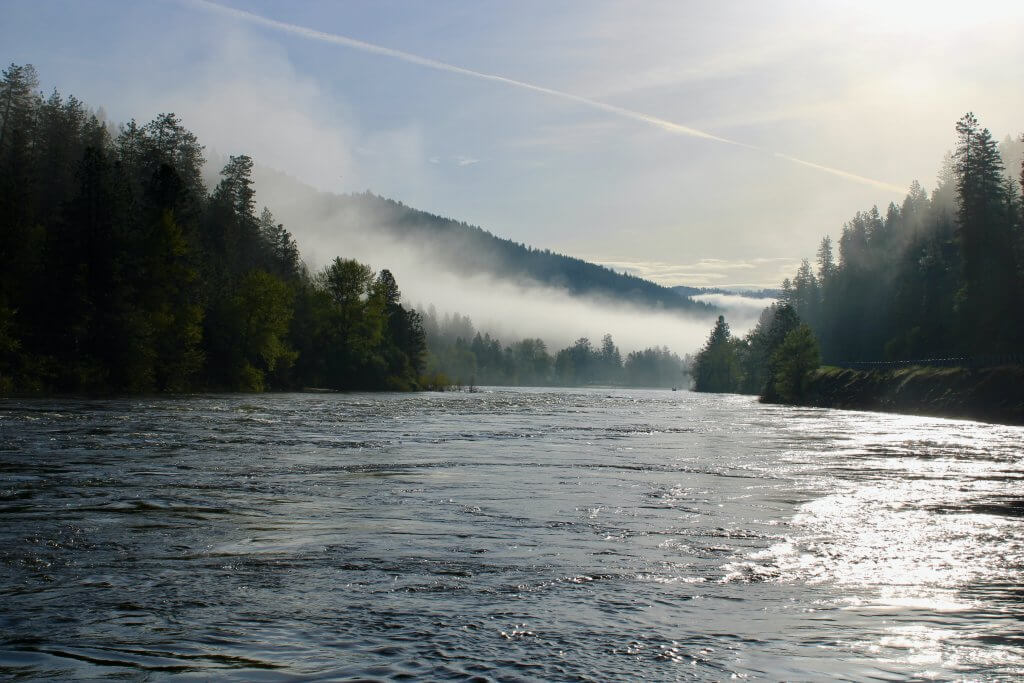Referred to as “mariners and mountaineers,” steelhead climb 6,000+ vertical feet and travel 900+ miles during their lifelong journeys from Idaho’s rivers to the ocean and back.
Connecting with an Idaho steelhead—notoriously powerful, built so swim the wildest terrain in the Lower 48 and increasingly difficult to catch—is a lifetime experience for many anglers.

Gem State Angling 101. What Is a Steelhead?
First thing’s first—a steelhead is a native rainbow trout that migrates to the ocean as a juvenile and returns to fresh water as an adult to spawn. Unlike Pacific salmon, which always die after spawning, steelhead can rejuvenate so they may return to the oceans to start the anadromous cycle over. Otherwise, steelhead and rainbow trout are genetically identical. A rainbow trout is called a resident when they do not leave the stream to go to the ocean and spend their entire life in the stream. On the other hand, a steelhead is the name for a rainbow trout expressing anadromous or seafaring life history.
Stick with us. There are two subspecies of steelhead, the Redband steelhead trout (Oncorynchus mykiss gairdneri) which all are categorized as summer-run fish and enter the Columbia River from May through September. The other subspecies is called the Coastal steelhead rainbow trout (Oncorhyncus mykiss irideus), which can be summer, fall and winter run fish. If you remember one thing, remember that in the Columbia River basin, Coastal Steelhead trout are largely found west of the Cascade Range and all steelhead returning to Idaho are Redband steelhead trout (Oncorynchus mykiss gairdneri) and therefore are all considered summer-run fish.

In Idaho, these steelhead are often classified into two groups, A-run and B-run, based on their size and ocean life history.
“Idaho’s A-run steelhead are usually found in the Snake and Salmon rivers,” Idaho Fish and Game explains, “They (A-run fish) return from the ocean earlier in the year (usually June through August) and they most often return after spending one year in the ocean. Because of their early return and short stay in the ocean they usually weigh four to six pounds and are generally 23 to 26 inches in length.”
B-run steelhead, exclusively found in Idaho are revered by anglers around the world. Most often, B-run steelhead return to the Clearwater River and some tributaries of the Salmon River. These fish usually—but not always—spend two years in the ocean and start their migration to Idaho later in the summer or fall of the year (usually late August or September). After packing on the pounds an extra year and waiting an extra summer of growing in the ocean, B-run steelhead can return as significantly larger fish.
Steelhead trout can grow even larger when they spend a third year in the ocean before they return to Idaho to spawn. These steelhead are usually larger than 37 inches and often weigh more than 20 pounds.
When Are Steelhead Trout in Idaho?
Steelhead fish can be found in the rivers of Idaho for the majority of the year. The sweet spot really depends on which river, time of year and method of fishing you prefer. Fall or spring—what’s your pick for Idaho steelhead season thrills?
Experience Fall Fishing: July–December
On the Snake River, fishing is best in September and October. The Clearwater River seasons open then, primarily for catch and release. Be sure to check the regulations. As the run builds, fishing will get better and better all the way through December, when colder water is likely to slow down catch rates. The Salmon River, further upstream, doesn’t really get going until well into October in the lower and mid-reaches.
Spring Fishing Awaits: January–May
January and February can be great times to fish with a little more solitude. The days are shorter and colder, with fewer anglers, but the fish are still out there. Idaho fishing picks up in late February and early March as ice dams begin to break up and allow fish to continue their upstream migrations. The Salmon River, the Little Salmon River and the South Fork of the Clearwater offer the best fishing before Idaho’s rivers close for steelhead spawning.
Fishing For Steelhead (Hint—You’ve Got Options)
So, you’re ready for Idaho steelhead fishing—now you just need to know how. Steelhead respond to a variety of angling techniques such as plunking, bobber and jig, fly fishing, side planer and spey casting with flies. Since steelhead are not feeding as they wait to spawn, it’s generally accepted that flies, lures and bait are agitating the fish enough to trigger a strike. While much is unknown about steelhead feeding habits, they are generally considered aggressive. As a general rule, cooler water temperatures make steelhead less active, meaning they’re less likely to travel farther to take your fly, lure or bait.
Idaho fisheries serve a mixed bag for anglers in the fall, but they’re world-renowned for fly fishing with spey rods (two-handed rods 13+ feet in length used to cast artificial flies over long distances).
Alternatively, spring fisheries, with cooler water temperatures, generally lower water levels and clearer conditions are generally better suited for fishing a fly, lure or bait under a bobber.
As always, be sure to check Idaho Fish and Game regulations on tackle regulations specific to different rivers at different times of the year.
Is This Species in Decline? What You Need to Know
While Idaho’s fisheries largely depend on hatchery fish production to support a sportfishing season, the future of Idaho steelhead depends on recovering wild fish populations. Wild steelhead carry the biological adaptations and genetic diversity that allow these icons to return each year to their high mountain natal streams, survive surging spring runoffs, multiple transitions between fresh and salt water and complete the 466-mile migration back to Idaho to spawn the next generation.
Historically, more than 40% of the salmon and 55% of the steelhead in the entire Columbia River system originated in the Snake River drainage. Before Idaho steelhead populations crashed in the late 1970s, records show 110,000+ wild origin steelhead returned to the Snake River basin above what is now Lower Granite Dam.

How to Identify Wild vs. Hatchery Steelhead Trout
Special fish deserve careful treatment—before you head out fishing, make sure you can clearly identify and differentiate between wild and hatchery steelhead trout.

Hatchery steelhead or salmon may be kept—within regulation limits—if the adipose fin (fin on the back of the fish between the dorsal and the tail) is clipped, marked by a healed scar. Anyone fishing for anadromous (ocean-run) salmon and/or steelhead, unless expressly exempt, must have a valid fishing license and the required salmon and/or steelhead permit(s) on their person. For more details on becoming a licensed angler—whether resident or out-of-state—and for information on seasons, bag limits and more, please be sure to visit Idaho Fish and Game website.
Daniel Ritz is a recovering journalist turned outdoor writer. Currently, he is the Communications and Outreach Coordinator of the Idaho Wildlife Federation, the founder of Jacks Experience Trading Company and the Conservation Field Editor for Swing the Fly. He lives in Idaho with his partner Holly, a giant cat named Julio and a small bird-dog named Trout.
Updated on April 29, 2025
Published on August 29, 2023

